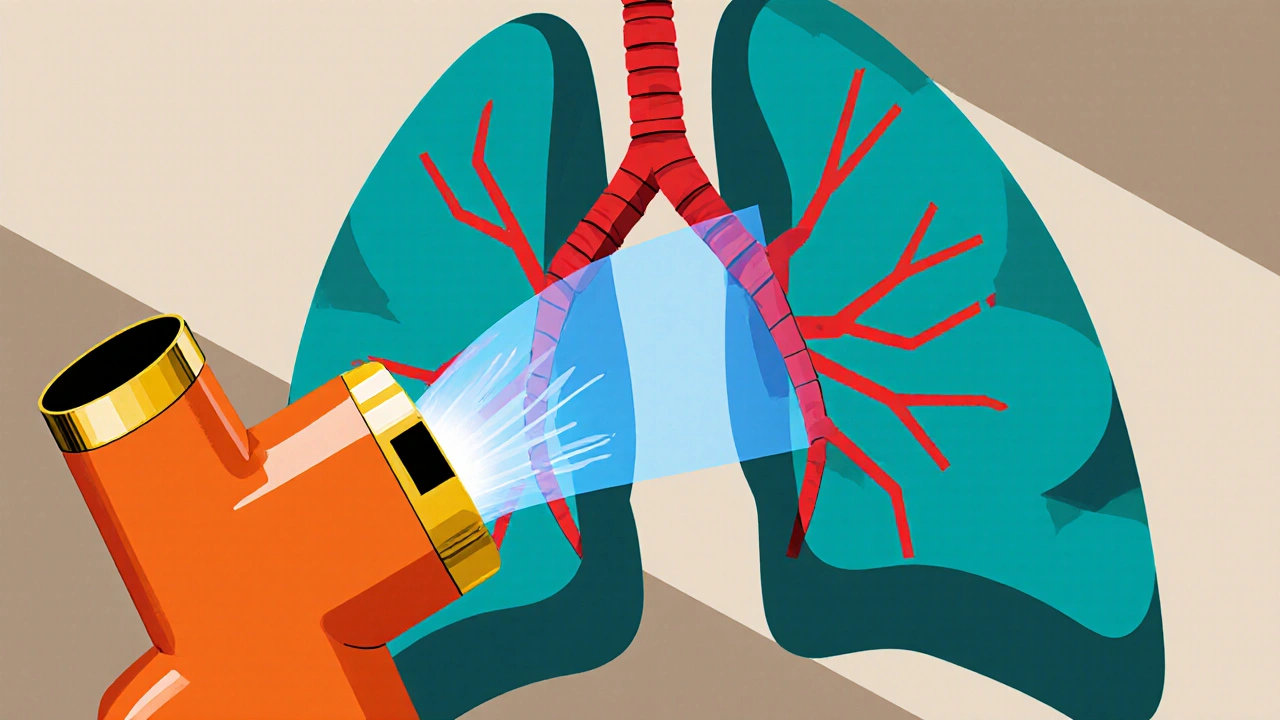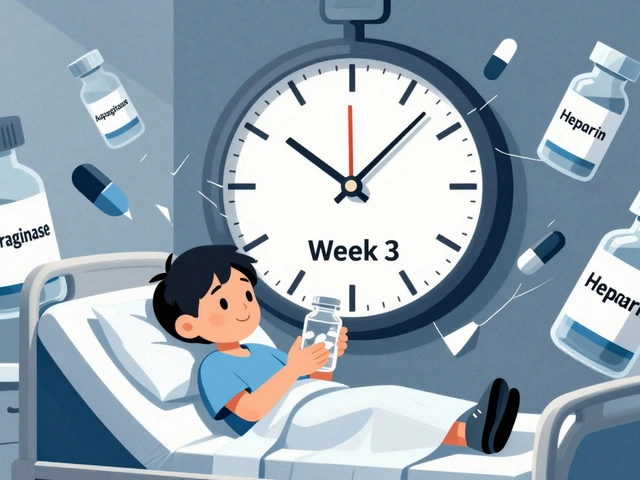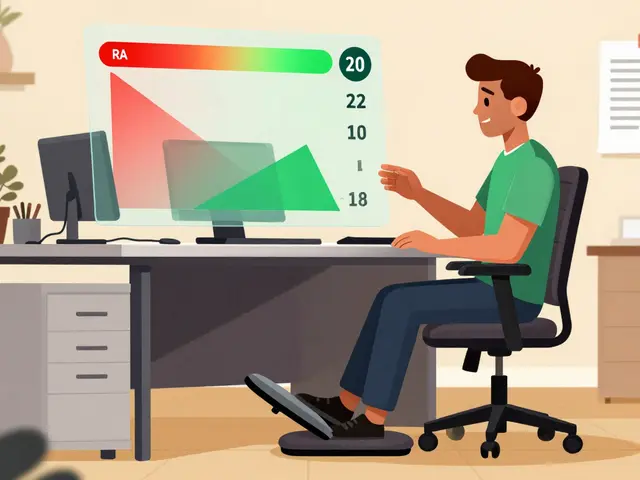
COPD Bronchodilator Treatment Calculator
COPD Treatment Guide
Use this tool to determine the appropriate bronchodilator therapy based on the GOLD guidelines for COPD management.
When you hear the word Bronchodilators are medications that relax airway muscles to improve breathing, you might picture a quick‑acting inhaler that relieves sudden breathlessness. In reality, bronchodilators are the backbone of Chronic Obstructive Pulmonary Disease a progressive lung condition marked by persistent airflow limitation management. From fast‑acting relievers to long‑acting maintenance options, each class plays a distinct role in keeping symptoms under control, reducing flare‑ups, and preserving quality of life.
Quick Takeaways
- Bronchodilators are the first‑line therapy for COPD because they directly open narrowed airways.
- Short‑acting β2‑agonists (SABAs) are rescue inhalers; long‑acting β2‑agonists (LABAs) and anticholinergics (LAMA) are maintenance drugs.
- Combination inhalers (LABA/LAMA or triple therapy) simplify dosing and improve outcomes for moderate‑to‑severe COPD.
- Choosing the right regimen follows the GOLD guideline’s ABCD assessment-symptom burden and exacerbation risk drive therapy.
- Common pitfalls include inhaler technique errors, over‑reliance on rescue meds, and ignoring comorbidities like heart disease.
Understanding COPD: The Disease Landscape
COPD develops slowly, usually after years of exposure to irritants like cigarette smoke, occupational dust, or indoor pollutants. Two pathological processes dominate:
- Emphysema - destruction of alveolar walls reduces gas‑exchange surface area.
- Chronic bronchitis - thickened airway walls and mucus hypersecretion narrow the lumen.
Clinically, patients report chronic cough, sputum production, and progressive dyspnea, especially during exertion. Spirometry remains the gold‑standard diagnostic test, measuring a forced expiratory volume in one second (FEV1) that typically falls below 70% of predicted in moderate disease.
How Bronchodilators Work: The Pharmacology in Plain English
Bronchodilators target smooth muscle tone in the bronchial walls. They either stimulate receptors that cause muscle relaxation (β2‑agonists) or block receptors that trigger contraction (anticholinergics). The net effect is a wider airway diameter, improved airflow, and easier breathing.
Two core mechanisms dominate:
- β2‑adrenergic stimulation - activates adenylate cyclase, raises cAMP, and relaxes smooth muscle.
- Muscarinic antagonism - blocks acetylcholine‑driven calcium influx, preventing bronchoconstriction.
Because COPD patients often have overlapping heart and lung issues, the choice of agent matters. β2‑agonists can raise heart rate, while anticholinergics may cause dry mouth but have a cleaner cardiovascular profile.
Classes of Bronchodilators and When to Use Them
Here’s a snapshot of the major families, their typical dosing, and the clinical scenarios where they shine.
| Class | Typical Agent(s) | Onset / Duration | Primary Role | Key Considerations |
|---|---|---|---|---|
| Short‑acting β2‑agonist (SABA) | Albuterol, Levalbuterol | 2-5 min / 4-6 h | Rescue relief | Tachycardia possible; avoid > 4 puffs/day |
| Short‑acting anticholinergic (SAMA) | Ipratropium | 5-15 min / 4-6 h | Rescue or adjunct to SABA | Dry mouth; less cardiac impact |
| Long‑acting β2‑agonist (LABA) | Salmeterol, Formoterol, Vilanterol | 10-30 min / 12-24 h | Maintenance therapy | May increase heart rate; not for acute attacks |
| Long‑acting anticholinergic (LAMA) | Tiotropium, Aclidinium, Glycopyrronium | 15-30 min / 24 h | Maintenance therapy | Best for patients with cardiac comorbidities |
| LABA/LAMA Combination | Umeclidinium/Vilanterol, Tiotropium/Olodaterol | Within 15 min / 24 h | Dual maintenance for moderate‑severe COPD | Improves lung function more than single agents |
| Triple Therapy (LABA+LAMA+ICS) | Fluticasone/Vilanterol/Umeclidinium, Budesonide/Formoterol/Glycopyrronium | 15 min / 24 h | Severe COPD with frequent exacerbations | Higher pneumonia risk; monitor inhaled steroid dose |
In practice, most patients start with a single long‑acting agent (LABA or LAMA) and step up to a combo or triple therapy as symptoms worsen or exacerbations increase.
Applying the GOLD Guidelines: Matching Therapy to Disease Severity
The Global Initiative for Chronic Obstructive Lung Disease (GOLD) provides a simple ABCD framework that combines symptom scores (mMRC or CAT) with exacerbation history.
- Group A: Low symptoms, 0-1 mild exacerbation - start with a short‑acting bronchodilator as needed.
- Group B: High symptoms, 0-1 mild exacerbation - initiate a single long‑acting bronchodilator (LABA or LAMA).
- Group C: Low symptoms, ≥2 moderate exacerbations or ≥1 severe - begin with LAMA (preferred) or LABA/LAMA combo.
- Group D: High symptoms, frequent exacerbations - step up to LABA/LAMA or triple therapy, adding an inhaled corticosteroid (ICS) if eosinophils ≥ 300 cells/µL.
By mapping a patient’s profile onto this grid, clinicians can pick the most cost‑effective and evidence‑based bronchodilator regimen.
Managing Exacerbations: The Role of Rescue Bronchodilators
Exacerbations are acute flare‑ups often triggered by infections or pollutants. Quick relief hinges on a fast‑acting bronchodilator, usually a SABA, sometimes paired with a SAMA for additive effect.
- Patient uses 2 puffs of albuterol, waits 2 minutes.
- If breathlessness persists, add 2 puffs of ipratropium (SAMA).
- If no improvement after 30 minutes, seek medical help-systemic steroids or antibiotics may be needed.
Education is critical: patients must carry their rescue inhaler, know the correct technique, and understand when to call their doctor.
Common Pitfalls and Safety Tips
Even the best bronchodilator regimen falters if patients misuse devices.
- Incorrect inhaler technique - missing lung deposition; a 30‑second video demonstration can boost adherence.
- Over‑reliance on rescue inhalers - suggests undertreated disease; prompt therapy escalation.
- Ignoring comorbidities - heart failure or arrhythmias may limit β2‑agonist use.
- Unmonitored steroid exposure - long‑term inhaled corticosteroids raise pneumonia risk.
Regular follow‑ups, breath‑lessness questionnaires, and spirometry checks catch these issues early.
Future Directions: New Bronchodilator Technologies
Research is pushing beyond traditional inhalers. Two trends stand out:
- Smart inhalers - Bluetooth‑enabled devices that log usage, remind patients, and share data with clinicians.
- Ultra‑long‑acting agents - molecules like once‑monthly tiotropium that could improve adherence for frail patients.
While still emerging, these innovations promise to tighten symptom control and reduce hospital admissions.
Key Takeaway Checklist for Clinicians and Patients
- Identify COPD severity using GOLD ABCD.
- Start with the appropriate long‑acting bronchodilator based on group.
- Prescribe a rescue SABA (and optional SAMA) for exacerbations.
- Review inhaler technique at every visit.
- Consider combination or triple therapy for frequent exacerbators.
- Monitor for side effects: tachycardia, dry mouth, pneumonia.
- Stay aware of emerging smart‑inhaler options.

What’s the difference between LABA and LAMA?
LABAs (e.g., salmeterol) stimulate β2‑receptors to relax airway muscles, while LAMAs (e.g., tiotropium) block muscarinic receptors to prevent constriction. LABAs are more likely to raise heart rate; LAMAs have a cleaner cardiac profile, making them a preferred first‑line choice for many COPD patients.
When should a patient move from a single bronchodilator to a combination inhaler?
According to GOLD, escalation is advised when symptoms remain high (CAT ≥ 10) or exacerbations occur two or more times a year despite optimal single‑agent therapy. A LABA/LAMA or triple inhaler then provides added lung‑function benefit and often reduces rescue inhaler use.
Are there any bronchodilators safe for patients with heart disease?
Long‑acting anticholinergics (LAMA) are generally safer for cardiac patients because they have minimal systemic effects on heart rate and blood pressure. If a β2‑agonist is needed, using the lowest effective dose and monitoring ECG changes is prudent.
How often should inhaler technique be reassessed?
At least every six months, or sooner after any hospitalization for COPD exacerbation. A quick 30‑second demonstration can reveal missed steps that dramatically lower drug delivery.
Do smart inhalers improve outcomes?
Early trials show improved adherence and reduced rescue inhaler use, especially in older adults. However, widespread adoption awaits insurance coverage and integration into electronic health records.









7 Comments
Your post is a textbook snoozefest.
The overview accurately delineates the pharmacologic distinctions between β2‑agonists and anticholinergics, yet it omits a critical appraisal of the cardiovascular risk profile associated with chronic SABA use. Moreover, the GOLD algorithm's integration of eosinophil thresholds warrants explicit mention, given its impact on inhaled corticosteroid selection. The table provided is comprehensive, but the dosing intervals for ultra‑long‑acting agents could be clarified to avoid therapeutic over‑lap. Clinicians should also be reminded that rescue inhaler over‑use is a prognostic indicator of disease progression. Finally, adherence monitoring via smart inhaler technology, while promising, remains limited by reimbursement constraints.
The mechanistic discourse on cAMP-mediated smooth muscle relaxation and muscarinic blockade was spot on, especially the emphasis on receptor selectivity. In practice, the pharmacokinetic half‑life differentials between tiotropium and aclidinium translate to divergent dosing schedules, which can affect patient adherence. It’s also worth noting that the synergistic effect of LABA/LAMA combos on pre‑bronchodilator FEV1 improvements has been quantified in several Phase III trials. Remember to counsel patients on device‑specific inspiratory flow requirements, as suboptimal technique can negate the theoretical pharmacodynamic benefits.
I feel the weight of every breath you write about swirling like a storm inside my chest and yet the words sit there like a calm lake they are beautiful and tragic and I cannot help but sigh in silent awe
While the article covers the essentials, it glosses over the nuanced decision‑making required when comorbid cardiac arrhythmias are present. The recommendation to default to LAMA in such scenarios is sensible, yet the potential for anticholinergic dry mouth to impair adherence is understated. Additionally, the brief mention of triple therapy fails to address the increased pneumonia risk associated with chronic inhaled corticosteroid exposure.
Great rundown! 👍 Keep spreading the word about proper inhaler technique – a little encouragement goes a long way for our folks battling COPD.
Let us consider the hidden agenda behind the proliferation of so‑called "next‑generation" bronchodilators. The pharmaceutical conglomerates have orchestrated a massive lobbying campaign to trademark terms like "ultra‑long‑acting" and "smart inhaler," thereby locking clinicians into a cycle of perpetual product upgrades. Each new device is engineered not merely for therapeutic benefit but to generate data streams that feed back into predictive algorithms designed to steer prescribing habits. By embedding Bluetooth sensors, manufacturers claim to improve adherence, yet they also harvest granular usage patterns that can be sold to insurance entities. This commodification of breath reduces a patient's autonomy to a set of metrics displayed on a cloud dashboard. Moreover, the pricing structures for these patented formulations often dwarf the cost of generic alternatives, creating financial barriers for low‑income populations. In many trials, the marginal gain in FEV1 is statistically significant but clinically negligible, raising the question of whether the incremental benefit justifies the inflated price tag. The marketing narrative glorifies convenience while obscuring the fact that device complexity can increase the risk of user error, especially among the elderly. Regulatory bodies, funded in part by the very companies they are supposed to oversee, have been slow to demand real‑world effectiveness studies. Consequently, we see a proliferation of devices that promise once‑monthly dosing, yet the evidence for sustained adherence beyond six months remains anecdotal at best. The broader implication is a healthcare system increasingly dependent on proprietary technology rather than evidence‑based, accessible medication regimens.